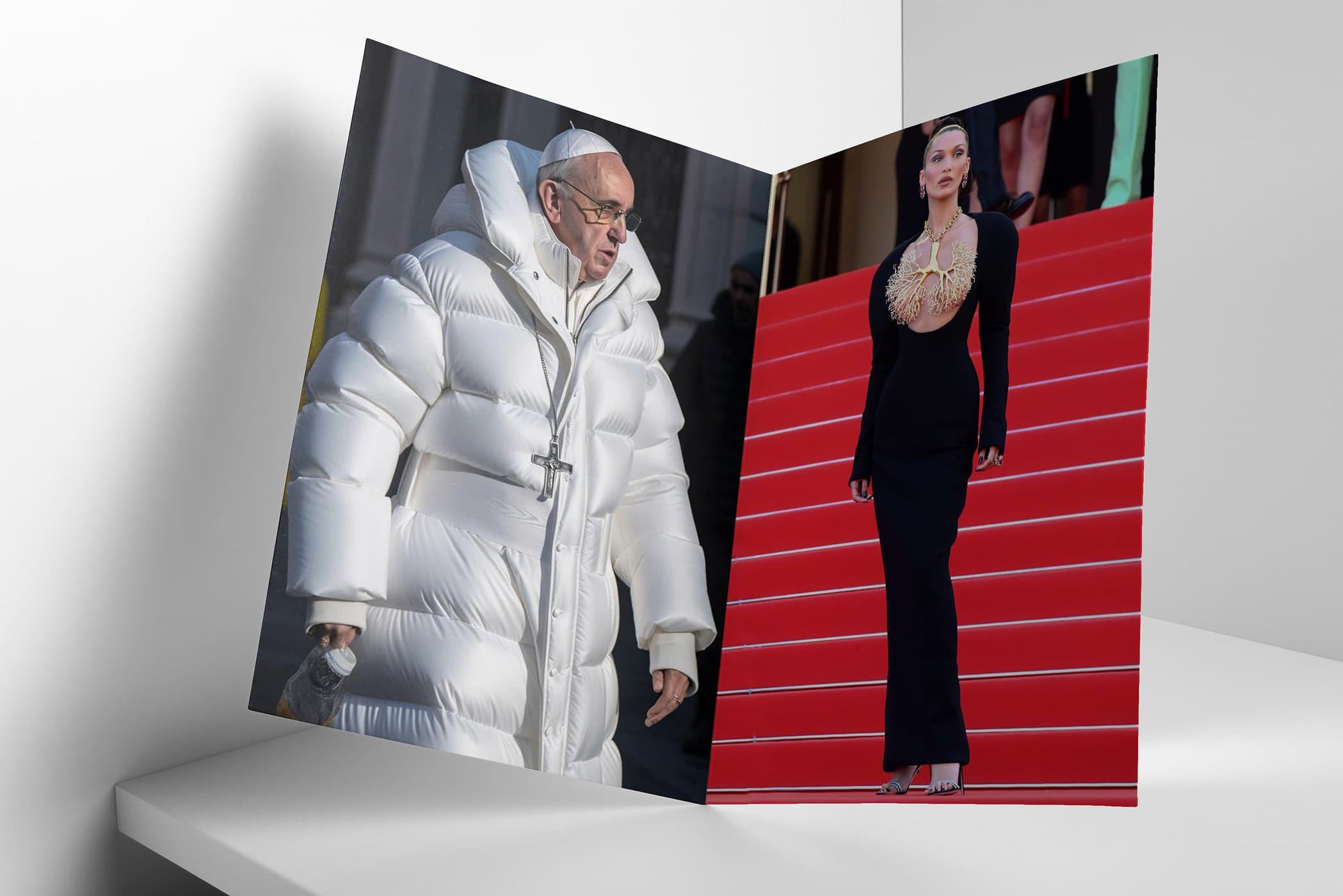How Brands Can Navigate the Legal Landscape to Protect their Intellectual Property from Counterfeits, Digital Dupes, and Unwanted Homage.
By Angela Baidoo
The recent raft of high-profile lawsuits by luxury’s major players has highlighted another key layer in the cost of doing business, and the importance of protecting ideas from being copied once they have entered the market.
There are laws in the United States and United Kingdom which recognise and offer legal protection to artists and craftsmen who produce artistic, musical, dramatic, or graphic works, but fall short of including the works of fashions designers, however avant-garde or innovative that work may be.
It is often left to brands to build a recognisable visual identity so that when disputes of intellectual property infringement arise there is enough evidence of its use in the market, and its associations with the designer as the original creator that rulings go in their favour.
For those just starting out in the industry, social media has become just as powerful a tool, temporarily filling in the voids where the law has yet to catch up, young brands can use their community to amplify their message and ‘out’ brands.
So, how can brands protect their intellectual property from a legal standpoint, both now and in the future? Especially when the AI revolution may compel lawmakers to re-look at centuries-old legislation to better suit the needs of designers operating in the industry. Here, at The Impression we take a deep-dive into the politics of protecting your brand, whether you have been established since 1854 or 2004.
Key Takeaways
Innovation over Digital Duplication: The luxury market is looking forward to future digital advancements, as generative AI leaps ahead as a more accessible and engaging tool which is being integrated into digital marketing strategies. Meaning brands at all levels of the market should prepare to extend their legal coverage into the metaverse, as the AI revolution is producing digital artists who aren’t shy about copying the aesthetics of luxury brands to go viral.
The Value in a Visual Identity: Young designers and emerging brands are following the lead of renowned luxury names by developing bold graphic patterns within their work as an additional form of default copyright, forgoing the logomania trend and instead building visual markers that will be strongly associated with their brand should their IP be infringed upon.
Legal knowledge is power: In the short-and long-term comprehensive training and education by institutions should be embedded to prepare future generations of designers for the necessity of copyright or trademark registration.
As well as the maintenance this requires in the form of renewals, while managing their expectations of the limits of the law in relation to the fashion industry.
Index
- What’s in a Name? From Losing it, to Licensing it
- The Ongoing Problem of Intellectual Property Protection in Fashion
- Whose Side is the Law On?
- Just Don’t Call it a Chanel
- Is (Digital) Imitation the Sincerest Form of Flattery?
What’s in a Name? From Losing it, to Licensing It
There have been many cases of designers seeking global expansion and opening their doors to outside investors, unwittingly putting their brand names at risk. The cautionary tales of designers such as John Galliano, and Manfred (formerly Thierry) Mugler serve as stark reminders of the perils associated with losing control over one’s own name and brand.
The 2021 Netflix mini-series “Halston” (chronicling the life and career of American designer Roy ‘Halston’ Frowick) highlighted the way in which the designers commercial brand partnerships with households names such as JC Penney, and proliferation of licensing deals which lent his name to products as varied as luggage, homeware, and wigs gave the masses incomparable access to his brand. In some circles this unrelenting expansion only served to dilute the brand’s exclusivity and cost Halston the right to trade under his own name. Speaking to Andrew Bravin, Media Lawyer, and Practioner-in-Residence at the London College of Fashion, he offered insight into what steps designers can take to avoid losing their name. In the first instance registering it as their trademark, Bravin said:

Many designers choose to trade under their own name and then register their name as a trademark. The key benefit of registering their name as a trademark is that it gives the designer the exclusive right to use it in respect of the goods registered.
– Andrew Bravin, Media Lawyer, and Partner with Sheridan’s, and Practioner-in-Residence with the London College of Fashion
For young designers this should be a consideration at the very start of their brand journey. You simply have to look at the way both Kim Kardashian and Beyoncé Knowles-Carter famously secured trademarks of their offspring’s names, Blue Ivy and North-West, pre-empting the incoming fame of their children as a keen example of early brand protection. Add to that the practice of opportunists acquiring a brand name across all social media platforms, then demanding a large payment as compensation before relinquishing ownership, and it makes a strong case for early registration. Bravin reiterated the proliferation of this practice when he confirmed:
In some territories, trademarks are first come, first served and so if a designer does not register their name and someone else registers it, then there could be a risk that they would be precluded from using it themselves. There are laws which provide protection for people using their “own names” honestly in commerce, and to stop people registering other people’s names in “bad faith” but the scope of those laws is fact specific. The take-home is that if a designer is going to trade under their own name, then it is sensible to (budget permitting) register trademarks in the key territories they want to use it in as soon as they can.”
– Andrew Bravin

Dormant fashion names are also sought out by conglomerates who want to add to their stable, with many gaining new relevance as all things nostalgia trends. With the majority having founders who have died or relinquished control of their trademarks, acquiring these long-forgotten names is a win-win in the world of competitive portfolio-building.
Patou, founded by French perfumier Alexandre Jean Patou was bought by the LVMH group in 2018, and relaunched under the artistic direction of Guillaume Henry. And in May, investment group Bidayat, obtained the intellectual property (IP) of Walter Albini with plans to relaunch the brand in the near future. Albini has been credited with spearheading what is today known as Milan Fashion Week, after showing his collections in the city when many were staging their events in Florence.



Passing the baton by reviving a brand, especially as a way to bring in fresh ideas and engage a new consumer base, is not necessarily a bad thing, as in recent years we have seen Marco de Vincenzo at Etro and Filippo Grazioli at Missoni reframing these brands to face into a new generation. While husband and wife duo Lucie and Luke Meier have found continued success and industry esteem at Jil Sander.
A designer lending out their name for a licensing deal or collaboration can mean emerging names can cash-in on their cache, and bigger names can harness the cool-factor of a built-in and engaged community. At a time when the age of entry into luxury continues to drop, it is no longer seen as a negative to collaborate with high-street retailers, sports brands, or culturally relevant food and drinks companies. Proving that a designer name – whether their own or their brands – will always act as a powerful incentive to purchase for the consumer.
The Ongoing Problem of Intellectual Property Protection
The way in which the law has failed to keep pace with the modern world is an ongoing concern for creatives in the industry. Think the explosion of the creator economy and the inherent value of fashion design, not just as a means of self-expression, but a significant contributor to the GDP of local economies on a global scale.
The current law in the US and definition of “useful Arts” is ripe for revaluation, as fashion as an artform whose progression deserves protecting should be included in a revision, because when a product is only deemed worthy of protection due to its ability to ‘encourage technological “innovation, advancement, or social benefit”’ according to the United States Copyright Act (Article I, Section 8, Clause 8.1 Overview of Congress’s Power Over Intellectual Property), there is a lack of understanding of the ways the end-product of a designers creative process can add value, beyond outward aesthetics.
Gucci is a luxury fashion house who are robust in the defence of their trademarks. Last week Gucci America Inc. filed three lawsuits against Century 21, Sam’s Club, and Lord & Taylor over the alleged selling of counterfeit goods. In the US region, Gucci also has several trademarks pending to protect its new creative direction under the newly appointed Sabato De Sarno. The new GUCCI ANCORA wording, as well as the words against the signature deep red background have both been submitted for trademark protection for goods and services to include perfume, eyewear, smartphones, NFTs, and real estate. And in a move which highlights how the company is looking towards the future of luxury ‘Downloadable augmented reality software for use in mobile devices…[and]…downloadable software for generating cryptographic keys for receiving and spending cryptocurrency’ were also included in the application, according to intellectual property law firm Gerben Law.
However, obtaining trademark protection is not the end of the legal journey, as if a brand who trademarks their logo lets it lapse for several years – as in fails to use it in or on their products – then it could be argued that the trademark should no longer stand.

With Gucci’s loss of trademark rights to its interlocking GG monogram (registered in 1984) in the UK in 2013 due to non-use serving as another cautionary tale. According to British law, a trademark registered in the UK can be revoked if not used within 5 years of its registration, and the Intellectual Property Office alleged that the brand had not sufficiently used their logo between 2003 and 2012 on handbags, T-shirts, watches, or cosmetics. With evidence provided to counter the IPO’s argument deemed as providing inefficient evidence of genuine use. This underscores the importance of actively using trademarks to maintain their validity.
The most common and widely used methods to safeguard IP is through copyright, trademark, or design rights protection, and are what brands should look to implement within their businesses as standard:
Copyright
In the UK the main function of copyright law is to “protect your work and stop others from using it without your permission” according to Gov.uk. It is applied automatically without the need to apply for it as “there isn’t a register of copyright works in the UK” (Gov.uk), which is good news if you have created original works of literacy, drama or art, software and web content, music, film, and television recordings. In many cases lasting the life of the creator plus 50 years (for written, dramatic, and artistic work), and up to 25 years for photographs. For designers their original sketches and graphic patterns will be protected under copyright law as they qualify as artistic works, but if seeking to cover their garment designs, they have the option of registering for the Design Rights (see below).
Passing the first copyright law in 1790, in the US copyright law falls under an umbrella of laws called intellectual property, as with the UK it grants rights to the original authors of works to benefit and profit from their intellectual property, as well as reproduce and distribute their work. According to Copyright.gov these include “literary, dramatic, musical, architectural, cartographic, choreographic, pantomimic, pictorial, graphic, sculptural, and audio-visual creations”, but elements such as colour or the way pattern pieces are cut or constructed together are not subject to copyright protection. Current law states that work created after January 1, 1978, is protected for the life of the author plus 70 years after death. Most commonly seen in cases of the production and selling of counterfeit goods, a practice which has expanded exponentially since the introduction of resale sites into the marketplace.
Trademark
Applies only to the name or logo. Trademarking as a tool of protection requires a level of maintenance, and due diligence, and registering a brand name in key international markets, especially if it is unique should be considered in the first instance. A lesson learned by streetwear brand Supreme in 2019, when their current owners VF Corp sued (Supreme Italia) business owners Michele Di Pierro and his son Marcello for operating a Supreme branded retail store in Shanghai. With the corporation winning damages totalling $10.4 million according to The Fashion Law. A country-by-country registration also provides some protection in the long-term. The US Lanham Act (Federal Trademark Law 15 U.S.C. 1051) also covers trademark infringement and allows for brands to sue their competitors if they are producing marks which are likely to cause confusion in the marketplace -a ruling in a brands favour can stop the infringement via an injunction and recover damages. An example of the violations the act covers include that of “A competitor [who] does not identically copy your marks but rather adopts a mark that is similar to yours and one that confuses consumers, i.e., they believe your competitors products are coming from you” according to Franchise Law Solutions.
Registered and Unregistered Design Rights
The UK also offers designers both ‘Unregistered Design Right’s’ and ‘Registered Design Right’s’, the former applied automatically upon the creation of a 3D object for a period of 10 years (after it was first sold) to 15 years (after it was created) with the stipulation that the creator has to provide evidence they are the originator of the design, as outlined on Gov.uk . The latter “helps protect the appearance of a product, such as its shape or pattern”, lasts for five years, up to a maximum of 25 years (Gov.uk).
The advent of social sharing sites (Tumblr, Instagram and TikTok) has made it even easier to ‘go fishing’ for inspiration, especially for businesses who operate at the ultra-fast fashion end of the market. Over the last decade a number of smaller, independent designers have accused Shein, FashionNova, Zara and Boohoo of copying their designs, and dependent on their financial capabilities, the most that any of these designers have been able to do is a community call-out via social media. These posts have often gone viral and gained the attention of the wider fashion press, which can pressurise these brands to remove the items from sale. But while social media can be a powerful tool for small brands this approach should be used with caution, as Andrew Bravin notes:
This is a tricky one. I have dealt with many situations where a designer’s intellectual property (including copyright) has been infringed and they want to go public about it. I totally understand the urge in sharing on social media the details of such an issue, especially where the infringer is not engaging with you in any other way. However, once you have gone public with a dispute you lose the ability to control the narrative as everyone piles in to comment and give their support or criticism of the matter. Harnessing communities and social media can be done effectively but it needs to be done carefully to minimise potential adverse results or legal risks associated with doing so.”
– Andrew Bravin, Media Lawyer, and Partner with Sheridan’s, and Practioner-in-Residence with the London College of Fashion
Due to the cyclical nature of fashion unless a design is particularly distinctive, for example, the silhouette of the Christian Dior Bar jacket (a house which benefits from a country whose laws around design protections are particularly robust, seeing as it is one of their most respected and lucrative exports), it can prove prohibitively expensive to an emerging brand to register their designs every season. But if the shapes you design can be attributed to you as the original creator, they can be protected under the Trade Dress Law. The Bar jacket is one example that would meet the required criteria because the fit-and-flare construction means the design is consistently attributed to Christian Dior, and as the feature is not essential to the jackets functionality, trademarking it would not monopolize a key product feature that would prove useful for other manufacturers in the market.



A strategic approach to copyright, trademark, and design rights is crucial for designers and fashion houses. Beyond legal protections, the industry as a whole needs a revision of the law to recognize and support the artistic contributions of fashion designers.
Whose Side is the Law On?
In the US as clothes are considered utilitarian, and therefore a practical necessity, it has been much more difficult for designers to copyright their work. There is also the fact that it’s hard to reinvent the wheel, even though fashion is an industry known for its habitual nature of re-working designs from different eras for new relevancy. It could be argued that classic trench coats from Hyke to Burberry and deconstructed trench coats from Sacai to Maison Margiela share a number of similar design traits – from construction to silhouette and design detail – so either one of them could bring a case against the other for copyright infringement. And while it may prove costly, those who have built a truly distinctive design language which can clearly be associated with their brand, there is every reason to take legal action, or at the very least send out a warning to those playing close to their designs.
It is not uncommon for alleged infringements to be perpetrated by those who operate at all levels of the market, bringing legal battles and lawsuits to the front pages. Over the last decade Christian Louboutin has sued Yves Saint Laurent (2011 – use of a red sole), Tiffany & Co sued Costco (2013 – use of the name Tiffany to sell engagement rings), Nirvana once sued Marc Jacobs (2019 – use of their yellow smiley face icon), and Versace sued Fashion Nova in 2019 when the Gen-Z favourite was ‘inspired’ by the brands instantly recognizable Jennifer Lopez ‘jungle print’ dress, which she wore to the 2000 Grammy Awards. A case which was settled before it was brought to trial. At the time the Italian luxury brand said, “Fashion Nova’s ability to churn out new clothing so quickly is due in large part to its willingness to copy the copyrighted designs, trademarks and trade dress elements of well-known designers, and trade on their creative efforts in order to bolster [its own] bottom line”.
Amplifying the double-edged sword of seasonal runways as a significant source of ‘inspiration’ which has led to fashion critics noting that collections with especially strong visual themes (see Balmain, Casablanca, or Versace from spring 2024) are likely to find themselves falling victim to fast fashion’s notoriously quick turnaround.

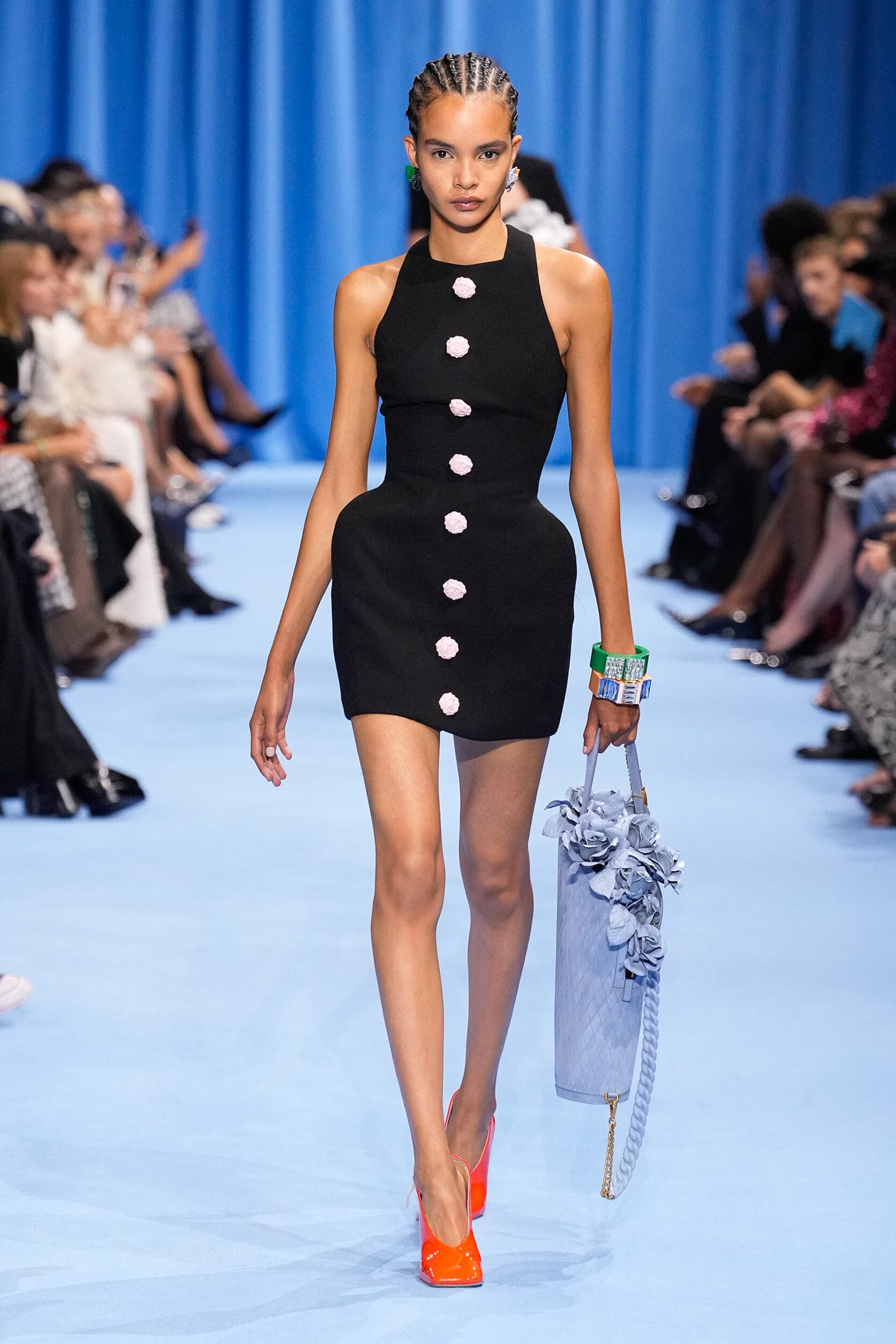
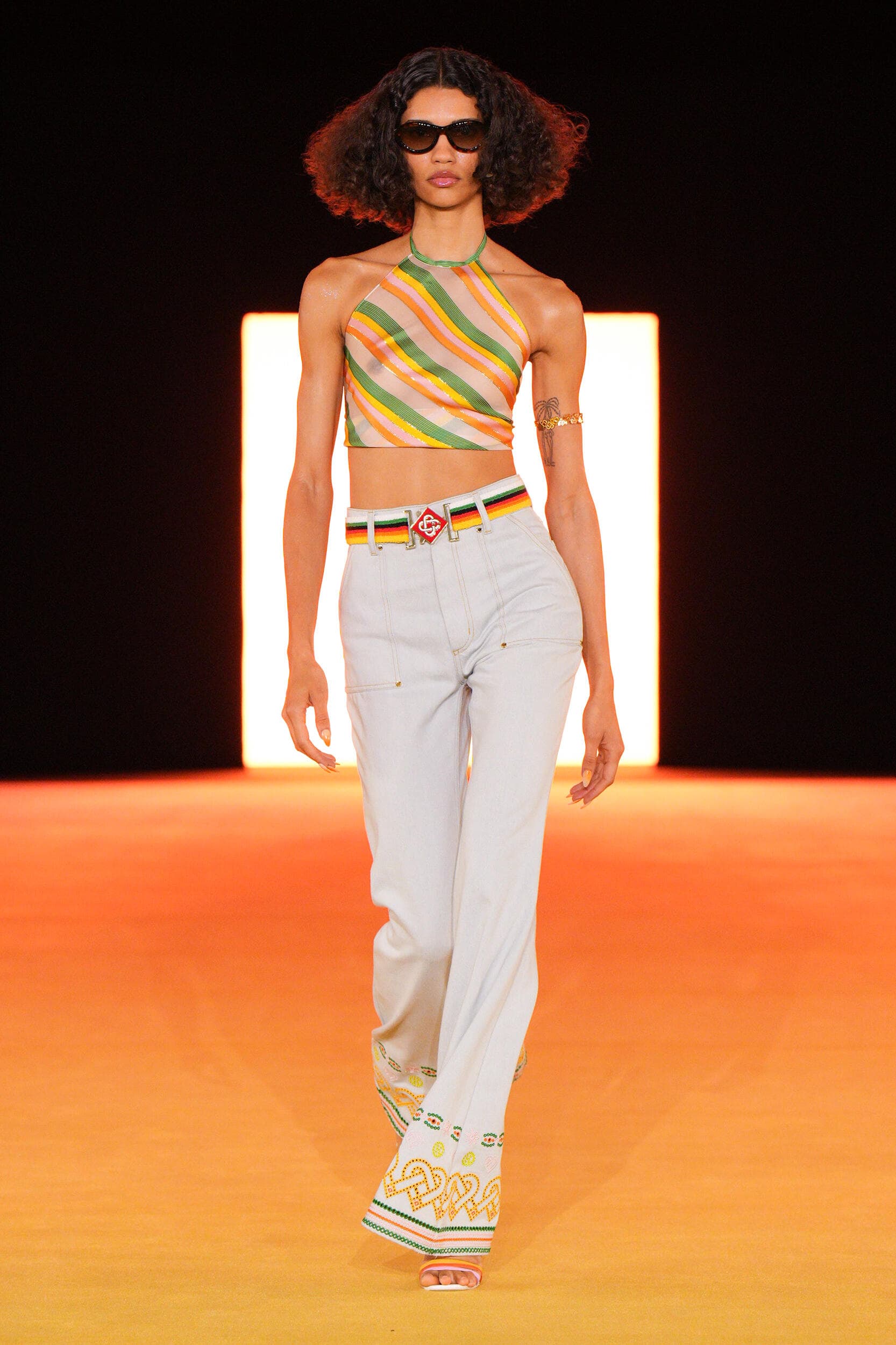
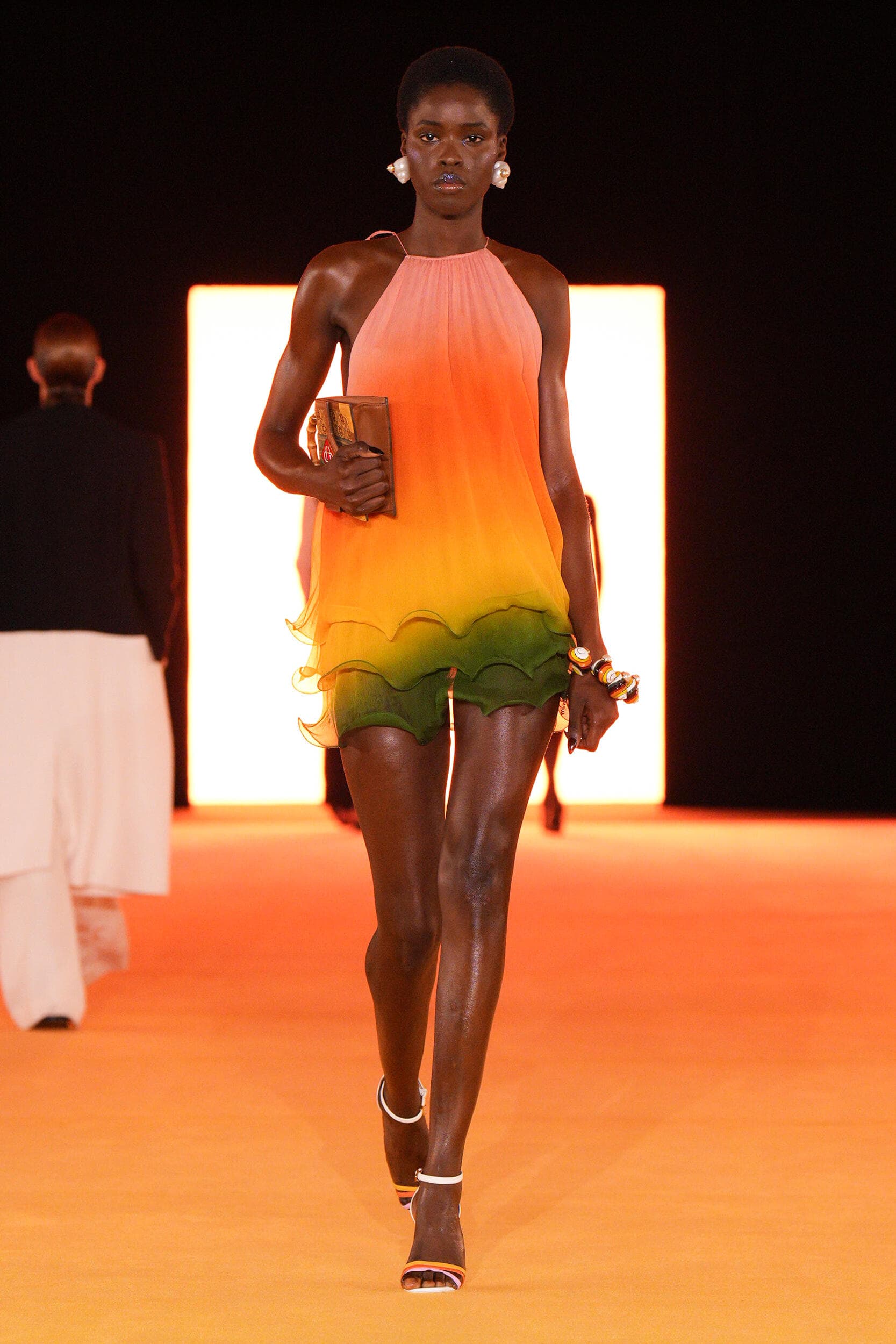
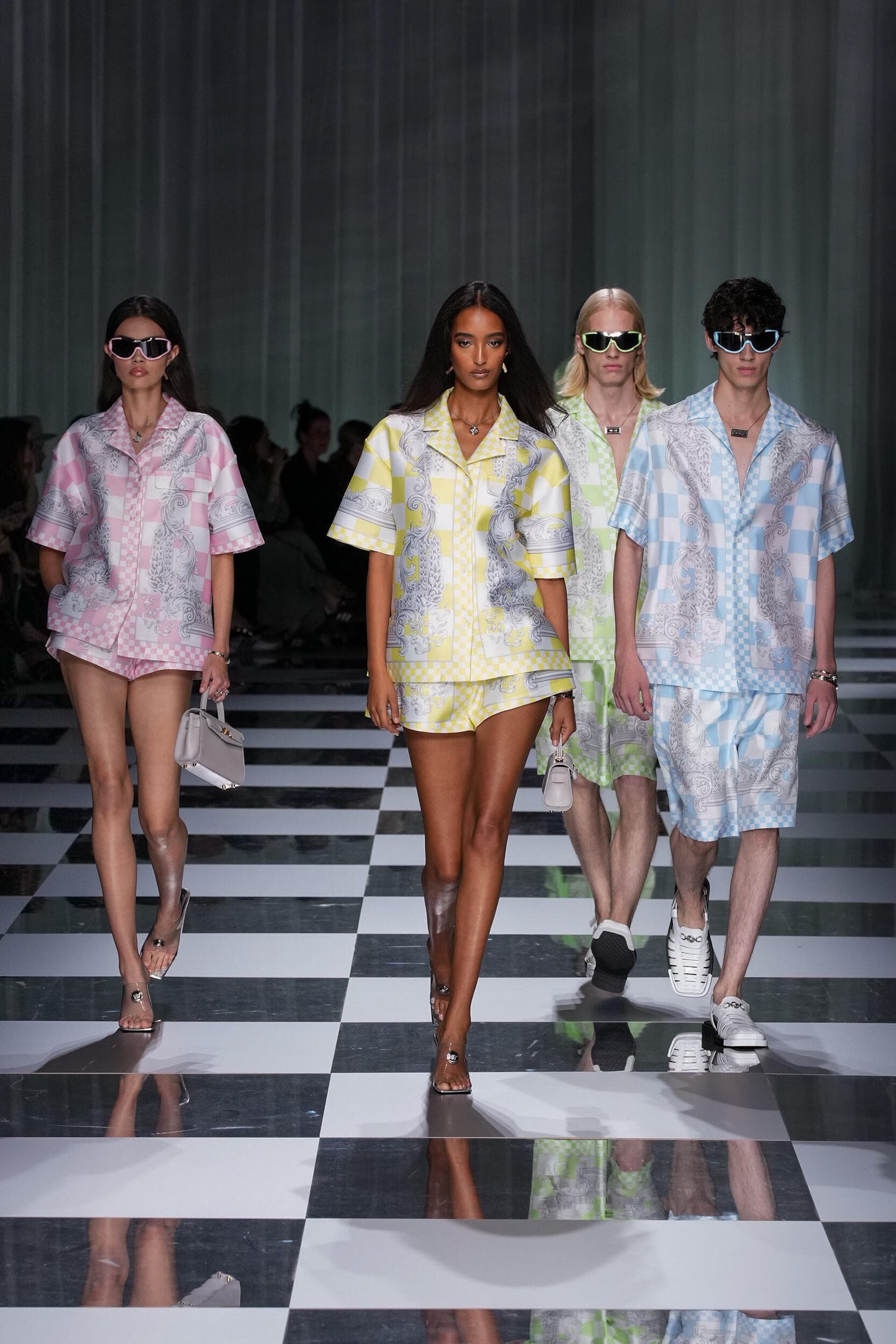

Fashion designers have lacked legal protection as standard, whether established in the last century or the last year. With the reasoning behind this decision outlined as the fact that clothing serves a utilitarian function and cannot be gatekept through trademarking or copyrighting. But U.S. law does afford protection to sculptural elements, forms of artistic craftmanship, and two-dimensional works such as fabric. As confirmed by the U.S. Copyright Office “Such works shall include works of artistic craftsmanship insofar as their form…are concerned” and “the design of a useful article (as defined in this section) shall be considered a….sculptural work only…to the extent that, such design incorporates…sculptural features that can be identified separately from, and are capable of existing independently of, the utilitarian aspects of the article”. This would effectively mean that the ‘Lung Dress’ from Daniel Roseberry’s fall 2021 Schiaparelli Couture collection (worn by Bella Hadid on the Cannes Film Festival red carpet) would have its ‘sculptural’ (i.e. lung necklace) element, protected. As this part of the dress could be worn (or exist) independently as a necklace. Jewellery as it stands is a category that is protected, but as is the confusing nature of the law even though the ‘Lung’ element could be considered separately from the dress – because it has a deep scoop in the front, exposing the wearers chest – the necklace performs an essential function to the design, contributing to its utilitarian functionality i.e. protecting the wearers modesty.
Just Don’t Call it a Chanel
In 2009, Chanel took out a full-page advert in Women’s Wear Daily (during a time when boxy tweed jackets were trending across high-street retailers), which gave notice to editors, advertisers, and copywriters on the mis-use of the Chanel name, stating:
Although our style is justly famous, a jacket is not a ‘CHANEL’ jacket unless it is ours…And even if we are flattered by such tributes to our fame as ‘Chanel-issime, Chanel-ed, Chanels and Chanel-ized’, PLEASE DON’T. Our lawyers positively detest them. We take our trademark seriously
– Chanel, Inc.
The French House has protected its intellectual property from as early as the 1920s, when the Chanel N°5 fragrance was trademarked in 1926, 6 years after it was created by Ernest Beaux for Gabrielle ‘Coco’ Chanel. Celebrating 100 years in 2021 the fragrance has gone on to become one of the world’s best-selling luxury products, contributing to their annual revenue of $12.27bn as reported by the Financial Times in 2021. Both its bottle design (which inspired Andy Warhol’s “Ads” portfolio and was ironically revisited by the house for a 1997 campaign), and the combination of the iconic words and number (Chanel+No+5) have enabled the brand to legally stave off any challengers who attempt to benefit from its powerful cultural relevance.
As was the case when Australian chocolatier Alison Peck, whose ‘Chocolate N°5’ brand was blocked from registering their logo as a trademark, due to it bearing a striking resemblance to the font and graphic composition of Chanel’s iconic perfume. Chanel’s legal team mounted a case to block Peck’s application (which she later withdrew), to safeguard against brand dilution, even though there are marked differences between perfume and chocolate. Chanel’s lawyers later uncovered that Peck had plans to register her logo in a similar black and white colourway, according to Fashion Business Law “Chanel’s main concern was that Ms Peck was also using and had applied to register as a trade mark the No. 5 label in a strikingly similar black and white font for perfumed candles” taking it into the expanded fragrance universe where the luxury house has established a significant presence.

Alison Peck | Photo by Kelly Barnes for News Corp Australia
Is (Digital) Imitation the Sincerest Form of Flattery?
The incoming threats and benefits from emerging technologies such as artificial intelligence (AI), NFTs, Avatars, and virtual spaces such as the metaverse, cannot be fully under-or-overestimated, so a proactive attitude to keeping abreast of insight around these areas is becoming business-critical.
The Fashion Law Business advises “if your business has an interest in joining the NFT marketplace, it would be wise to update any trademarks currently used to include NFTs. This can be done by filing an intent-to-use application if you are not ready to immediately enter the digital realm”
There is no doubt that the digital, or rather generative AI takeover is coming, but brands should see it as a force for good rather than evil, especially when harnessed correctly i.e. avoiding the erasure of diversity or perpetuating stereotypes of marginalised groups and beauty ideals through human intervention throughout the development process. By engaging with AI tools such as Midjourney (an artificial intelligence program which creates hyper-real images from natural language prompts), young, independent, and luxury brands can utilise it to reimagine their marketing campaigns and customer journeys via more expansive storytelling.

Pangaia’s FLWRDWN Collection and Virtual Experience Created by AnamXR
Collina Strada founder Hillary Taymour created ‘Animorphs’ for her fall 2021 collection, inspired by the 2000 sci-fi book of the same name, her models morphed into frogs, snakes, and cats, or ‘Collina-mals’. And Pangaia created a virtual Arctic immersive experience with AnamXR and the Fashion Innovation Agency to celebrate the launch of its FLWRDWN collection, that also served as an innovative e-commerce platform and confirmation of a new-era in customer engagement.


Photographer, AI hobbyist and YouTuber Demon Flying Fox has gone viral for their skills in merging classic films and popular TV series with the aesthetics of some of luxury’s most renowned names, by creating highly-stylised short videos. Game of Thrones, Breaking Bad, Pulp Fiction and The Sopranos have all been made over using AI and posted on the creators Instagram account, with instantly recognisable details and uncanny likenesses. But it was his Harry Potter reimagining in March 2023, which garnered over 11M views on YouTube and 482 thousand on Instagram, as the high-fashion take projected Balenciaga’s darkly dystopian visual identity onto the best-selling fantasy series. The video was widely shared, drawing in devotees of the books, digital creators, and fashion fans alike.
This digital artwork, in homage to the luxury house and fantasy-book characters, highlights the opportunity to engage a highly lucrative cross-section of consumers simply waiting to be inspired to purchase the brands who’ve tapped into the hype around Demon Flying Fox’s digital art to create a campaign. It is also not outside the realms of possibility that the next step could be a Cease and Desist from Balenciaga’s legal team, who could raise the challenge that these short videos are creating a sense of confusion with the consumer, who may assume the French luxury house has co-signed the videos currently on YouTube and Instagram.

This year’s viral AI image of the Pope in a puffer coat duped many into believing the image was genuine. After creating a storm on the internet, the AI-image creator Pablo Xavier became a victim of his own success when the images he created of Elon Musk and female robots were co-opted by another creator who failed to give Xavier credit. As a way to prove ownership, Midjourney provides a seed number which is associated with every image generated on the platform so users can provide evidence that they are the original creators. But users of the AI tool have started conversations around the additional need for crediting features to be embedded in the technology – such as watermarks – to identify a particular artist and their work. Xavier also highlighted that it would go some way to help clarify if an artwork has been made using AI. As with his watermark attached and his reputation as a prolific AI artist, viewers would immediately be able to identify that the Pope is in fact not wearing a Balenciaga puffer jacket.
Whether they are aware of it or not, major brands are already participating with (and in) the digital world, but for now it is mostly as a source of reference and inspiration. Take for example a collaboration between digital artist Kalista and Dressx, it could be argued that the designs bear a striking resemblance to the combined collections of Ann Demeulemeester (fall 2024) and Tom Ford (spring 2023), by way of vintage Issey Miyake (fall 1980/81) and Di Petsa (fall 2023) . Demonstrating that the industry’s influence is already evident in the metaverse, whether it crosses over into the world of IP infringement is yet to be seen, unless more cases like the Hermés x MetaBirkin trial start to become the norm.


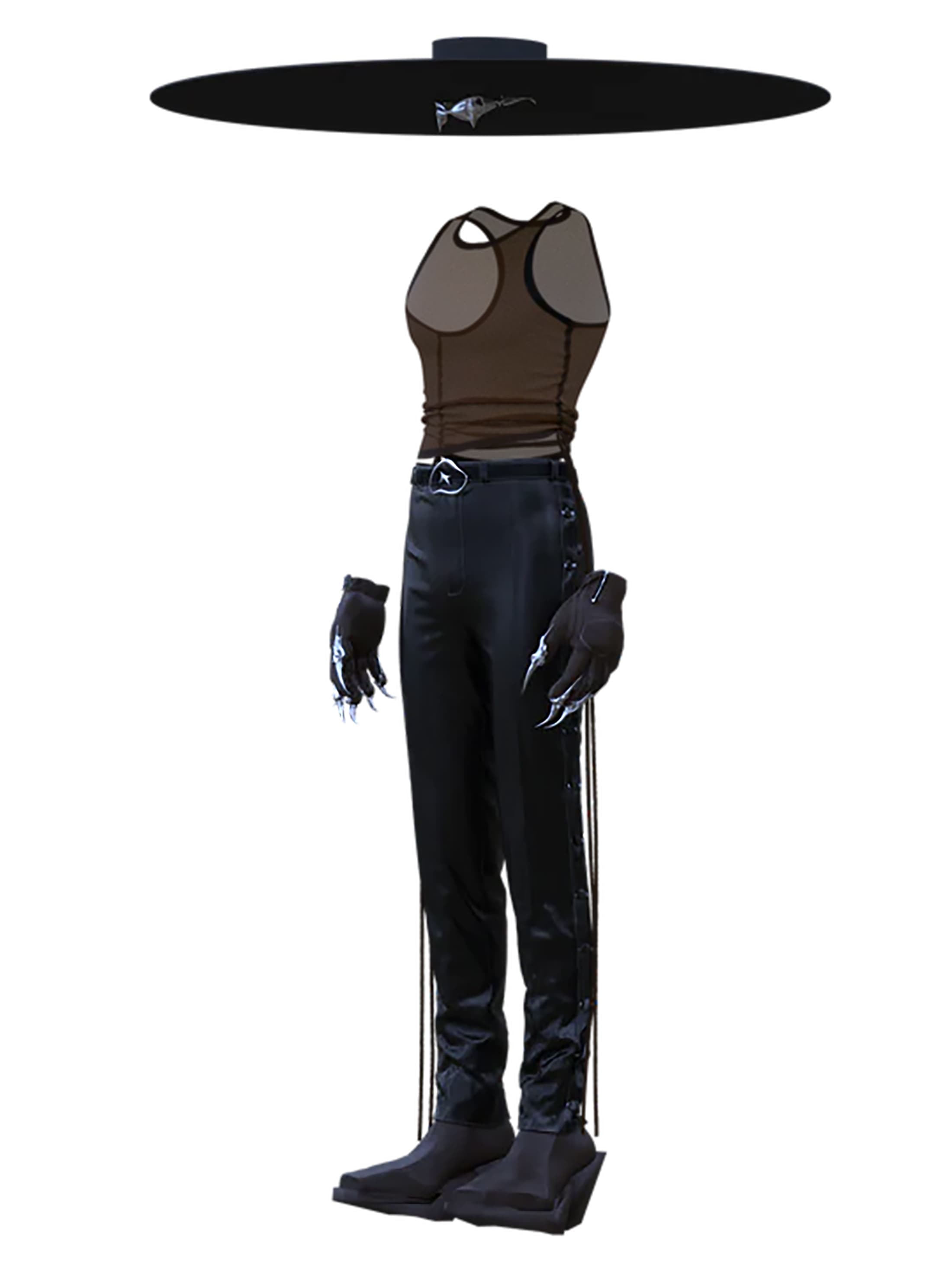

Trademark dilution will be an ongoing concern if more luxury players don’t accelerate their participation in the digital realm, as so far only a handful of names – Gucci, Louis Vuitton, Burberry, Valentino, Ralph Lauren, and most notably Balenciaga – have exploited digital design in creating collections for gamers or dressing digital avatars. Fully immersing themselves in the potential of the metaverse and gaming, Balenciaga created a ‘Fit Set’ of outfits for players in Fortnite in 2021 (with a real-world cross-over in a capsule collection), as well as a collection for Meta’s Avatar store.
Brands should tap into this revenue opportunity through premium price points which reflect their luxury status rather than devaluing their reputation through imitations by other digital creators.
The Solution Remains Far from Simple
An easy, if not wholesale solution, for both emerging and established designers is simply to cover designs in a trademarked logo, print or pattern. Or incorporate sculptural elements which can be worn independently of the clothing designs they were developed for, but this puts the onus back on creatives to solve a problem which should be written into law. By following these guidelines, it will make it easier from a trademark or design registration standpoint but will stifle the very creativity and innovation many of these laws were put in place to foster. Fashion designs are an art form, but don’t necessarily stand alone as works of art, unless you are considering bespoke couture creations. Despite the gaping holes in the law – worldwide – designers entering the market should not be required to become the next Alexander McQueen or Daniel Roseberry to qualify for the legal rights over their work. Protection should be afforded whether a designer is creating contemporary eveningwear known for its multi-strap construction interspersed with gathered chiffon (Nensi Dojaka), or minimalist silhouettes inspired by heritage and tradition and storytelling combined with organic textures and sharp cuts (Bevza).
When it comes to the digital landscape there is also no requirement for brands to have to digitise their entire back-catalogues in order to claim copyright protection, as according to Moin Roberts-Islam of the Fashion Innovation Agency:

Big brands like Hermés have the budget and the legal teams required to identify and prosecute these sorts of (MetaBirkin) infringements – or indeed potential infringements. They were able to successfully try this case in court and win, without the need for a digital back catalogue – they had sufficient means of enforcing their stance with traditional methods. I do not think we will see a rush of brands digitally capturing their back catalogues for this purpose – if they do, it will be more likely influenced by a new marketing or archiving initiative.”
– Moin Roberts-Islam, Technology Development Manager, Fashion Innovation Agency
Outside of major changes in the law which seem to be a long way off, or making incremental amendments which don’t go far enough, what would cause a major shift is a change in attitude in the way fashion is perceived. Despite being a billion-dollar industry, it is still considered frivolous, throw-away or simply utilitarian, which disregards the well-documented cultural and historical impact the industry has had on daily and working life, film, music, art, and the digital world. Only then can designers begin to expect to be granted the protection over their creative work they need. In the interim designers should continue to use the law, bring cases to the forefront that will assist in evolving current laws, and continue to fight for their brands reputation and intellectual property. Whether that’s a full-page ad in the fashion press or rallying their community to raise awareness and highlight when they have been infringed upon by providing evidence of correspondence and the creative process.
